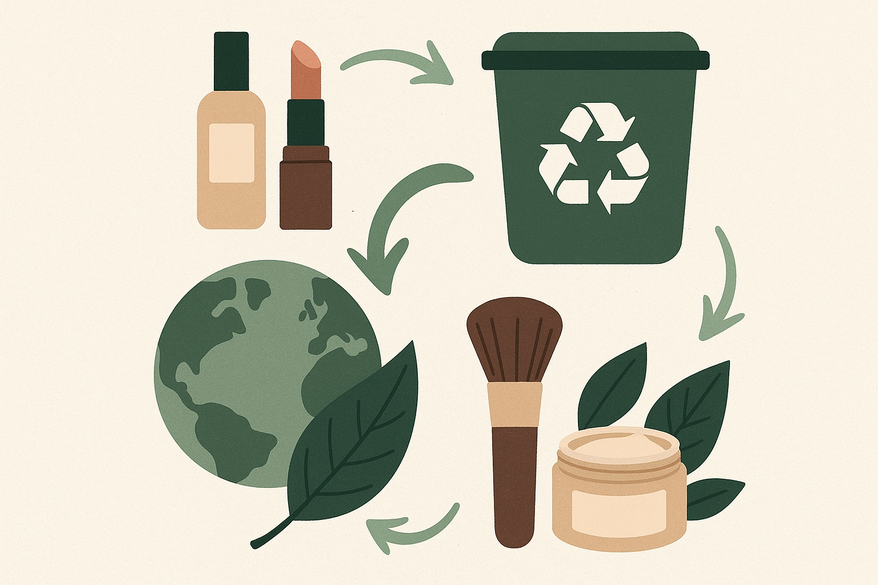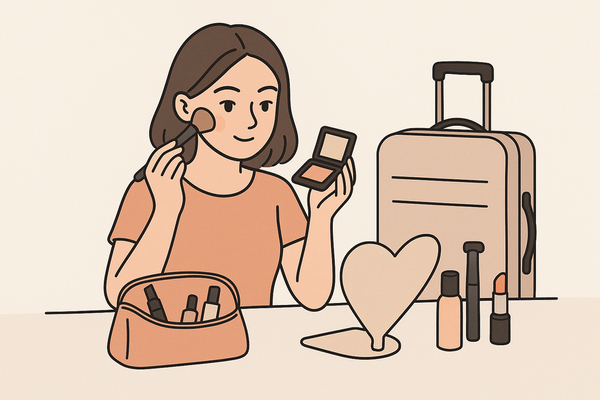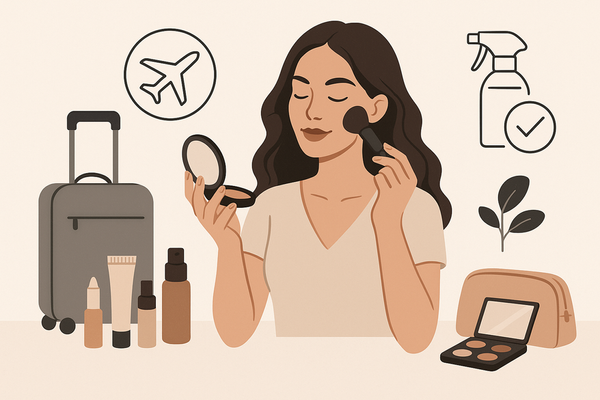Eco-Friendly Makeup Disposal: Your Ultimate Guide to Greener Beauty
Learn eco-friendly makeup disposal methods to reduce waste and protect the planet. Discover recycling, repurposing, and sustainable beauty tips.

Estimated reading time: 8 minutes
Key Takeaways
- Improper makeup disposal contributes to persistent landfill pollution and chemical runoff.
- Cosmetic packaging often combines mixed materials that challenge municipal recycling systems.
- Practical solutions include hazardous waste drop-off, container recycling, repurposing, and waste minimization.
- Alternative options such as refill programs, manufacturer take-backs, and virtual try-ons reduce single-use waste.
- Implementing home sorting systems and leveraging local resources fosters sustainable beauty habits.
Table of Contents
- Introduction
- Understanding the Problem
- Importance of Eco-Friendly Makeup Disposal Practices
- Methods and Tips for Eco-Friendly Makeup Disposal
- Alternatives to Disposal: Eco-Friendly Makeup Disposal Options
- Practical Implementation for Eco-Friendly Makeup Disposal
- Further Reading & Organizations
- Conclusion
Introduction
Every year, millions of makeup containers end up in landfills, adding to the 120 billion units of cosmetic packaging produced globally. Eco-friendly makeup disposal starts with recognizing that our beauty routines can either harm or help the planet. “Improper disposal of makeup and cosmetic products can contribute significantly to environmental pollution.” — Shapiro Environment
Eco-friendly makeup disposal is the set of practices that reduce environmental harm by recycling, reusing, and properly handling cosmetic products and their packaging. When you swap tossing your old foundation in the trash for recycling its glass jar, you directly protect ecosystems and public health.
This guide will equip you with clear, actionable steps for environmentally responsible makeup disposal. You’ll learn why traditional methods fail, discover practical solutions, and find local resources to turn your vanity habits into a force for sustainability.
Understanding the Problem
Traditional disposal of cosmetic products often means tossing expired lipstick, mascara wands, and empty powder compacts into the household trash. Those items then sit in landfills for centuries, releasing microplastics and chemicals over time.
Material Challenges
- Many makeup containers combine plastics, glass, metal, and rubber seals that municipal recycling systems cannot sort.
- Complex packaging—like lipstick tubes with mirrored surfaces or multi-layer plastic pouches—usually ends up incinerated or buried.
- Containers made from mixed polymers may carry toxic residues, complicating mechanical recycling. “Many makeup items contain plastics that take centuries to degrade, and their chemical components can leach into soil and waterways.” — Happen Ventures
Chemical Risks
- Preservatives such as parabens and formaldehyde releasers can leach into groundwater.
- Heavy metals (for example, lead in some lipsticks or arsenic traces in pressed powders) build up in ecosystems and potentially harm wildlife or human health.
- Liquid products like nail polish often contain flammable solvents that pose hazards in landfill fires. “Chemical components in cosmetics can leach into ecosystems, contaminating soil and water.” — Happen Ventures
Importance of Eco-Friendly Makeup Disposal Practices
Embracing green disposal methods delivers both environmental and social returns.
Environmental Benefits
- Reduces landfill volume and cuts microplastic pollution.
- Minimizes chemical runoff into rivers and aquifers.
- Supports global sustainability goals and drives a circular economy of reuse. “Eco-friendly disposal aligns with moves toward a circular economy.” — Happen Ventures
Economic & Community Benefits
- Refillable packaging and take-back programs can save consumers money over time by reducing repeat purchases of full containers. “Refillable packaging offers both cost-effectiveness and environmental gains.” — eFulfillment Service
- Donating unused products to shelters builds community support and prevents waste.
- Local cleanup drives or swap events foster collective responsibility for shared resources.
By choosing eco-friendly makeup disposal, you help curb plastic waste, protect water quality, and reinforce ethical consumption patterns.
Methods and Tips for Eco-Friendly Makeup Disposal
Below are five proven methods to manage your cosmetic waste responsibly.
- Hazardous Waste Drop-Off
• Identify products with chemicals/heavy metals: eyeliner pencils, nail polish, chemical peels.
• Use municipal household hazardous waste facilities—most cities list collection points online.
• Example: I visited my county’s environmental center and safely dropped off old nail polish instead of flushing it. “Many localities accept cosmetics as household hazardous waste.” — Shapiro Environment - Recycling Containers
• Separate materials: glass jars from compacts, aluminum lids, and plastic tubes.
• Rinse and air-dry containers to remove residue.
• For mixed or hard-to-sort items, use TerraCycle’s beauty recycling program. - Repurposing & Donating
• Donate unopened, unexpired cosmetics to women’s shelters or community centers.
• Repurpose empty palette pans as miniature storage trays for craft supplies.
• Turn clean foundation bottles into plant watering spikes by poking holes in the cap. “Unused cosmetics can be donated to shelters, reducing waste and benefiting communities.” — Happen Ventures
• For more creative reduce-and-reuse hacks, see our DIY makeup hacks. - Minimizing Waste Upfront
• Choose minimal or refillable packaging when shopping.
• Store products in a cool, dry place to extend their shelf life.
• Track open dates—note expiration symbols to prevent early disposal. “Participating in refill and reuse programs lowers plastic waste.” — eFulfillment Service - Advanced Recycling & Waste-to-Energy
• Some regions employ pyrolysis or anaerobic digestion to convert cosmetic waste into biofuel.
• Check if local waste-to-energy plants accept cosmetic residues. “Some regions process cosmetic waste into biofuel via advanced recycling.” — Happen Ventures
Alternatives to Disposal: Eco-Friendly Makeup Disposal Options
When possible, skip disposal altogether by opting for sustainable alternatives. Explore clean beauty trends in our Clean Beauty Makeup guide.
Refill Programs
- Brands such as Lush and Kiehl’s offer in-store refill stations for shampoos, creams, and cleansers.
- Refillable products cut single-use packaging and often cost less per ounce. “Refillable products significantly cut single-use waste.” — eFulfillment Service
Manufacturer Take-Backs
- Check brand websites for take-back schemes—MAC’s Back to MAC partners with TerraCycle to recycle empty containers.
- Many luxury labels provide prepaid shipping labels for returns. “Some brands accept empty containers for proper recycling or reuse.” — TerraCycle
Donation of Gently Used Products
- Confirm hygiene regulations before donating partially used lotions or sprays.
- Acceptable items often include bars of soap, hair care products, and sealed skincare kits.
To further reduce waste from physical swatch tests, many beauty enthusiasts are turning to virtual try-ons with Makeup Check AI. This AI Makeup Generator lets you experiment with shades digitally, cutting down on sample packaging.
Practical Implementation for Eco-Friendly Makeup Disposal
Finding Local Facilities
- Use Earth911.com or your city’s waste management website to find drop-off points for hazardous and recyclable waste.
- Check household hazardous waste event calendars each spring and fall.
Home Sorting System
- Label bins or boxes for “Hazardous Waste,” “Recycle,” and “Donate.”
- Store near your vanity or laundry room for easy access.
- Empty and clean bins weekly to avoid confusion.
Retailer Collection Bins
- Many beauty stores partner with recyclers: Sephora, Ulta, L’Occitane, and Origins offer in-store collection points.
- Ask at checkout or check the retailer’s website for program details.
Further Reading & Organizations
- TerraCycle’s beauty recycling page
- Your local municipal waste pages for guidelines and event schedules
Conclusion
Eco-friendly makeup disposal protects our planet by reducing plastic pollution, preventing chemical runoff, and closing the loop on cosmetic packaging. By recycling containers, donating usable products, and choosing refillable options, you can transform your beauty routine into a sustainable habit. Start now: audit your makeup stash, implement one disposal method this week, and share these tips with friends. Together, we can make green beauty the standard.
FAQ
Can all makeup containers be recycled?
Not all. Multi-material or heavily soiled containers may be rejected by curbside programs. For complex items, use specialized recyclers like TerraCycle. “Many localities accept cosmetics as household hazardous waste.” — Shapiro Environment “TerraCycle accepts beauty products that municipal recycling often rejects.” — TerraCycle
What do I do with expired liquid products?
Treat them as hazardous waste. Never pour nail polish, remover, or toner down the drain. Drop off at designated municipal sites.
Are cosmetic chemicals harmful in landfills?
Yes. Heavy metals and preservatives can leach toxins into soil and water over time, posing risks to wildlife and humans. “Chemical components in cosmetics can leach into ecosystems, contaminating soil and water.” — Happen Ventures




